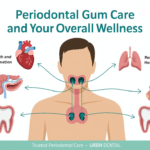Your children will reach six, and at this age, the baby teeth begin to fall out. You may be concerned about your child’s permanent teeth growing correctly. When the temporary teeth fall out, you will see that the permanent teeth are taking their place. To preserve the health of permanent teeth, we must teach children about the importance of oral hygiene. Some children suffer from severe dental illnesses that may require a tooth extraction. Everyone, whether a child or an adult, suffers from an oral disease due to their busy lives and disregards the significance of oral care. Additionally, if you do not maintain your oral health, some people may have to lose their teeth.
People who have had a tooth extracted will experience minimal pain and discomfort. However, if the extraction was performed on molars or wisdom teeth, you may get a dry socket.
What is a dry socket?
A dry socket (alveolar osteitis) is an oral disease that occurs following a tooth extraction procedure. Following a tooth extraction procedure, a blood clot should form on the treatment site; you may suffer from a dry socket if this does not happen.
A blood clot forming around the tooth extraction site is required because the blood clot functions as a protective covering for the underlying bone and nerves in the tooth socket. Clotting acts as a foundation for the formation of new bone and the expansion of soft tissue over the clot. It can cause pain and make the region difficult to heal.
What causes dry sockets?
It is difficult to pinpoint the exact cause of a dry socket because the condition is still the subject of study. However, the cause of a dry socket might include factors such as;
- Infection at the treatment site after tooth extraction.
- Bacterial contamination at the surgical site of impacted wisdom tooth extraction.
- Consumption of birth control pills.
- Improper oral care after tooth extraction.
What are the symptoms of dry socket?
After tooth extraction, blood clotting forms at the surgical site, creating a protective layer to protect the socket from bacteria in your mouth. According to the sources, a blood clot does not form in 2% of tooth extractions and 20% of impacted wisdom tooth extractions. And if it does become dislodged, it will result in a dry socket.
A dry socket is usually accompanied by bad breath and a bad taste in the mouth. Pain may spread from the affected site to the surrounding tissues in the neck, face, and ear. Furthermore, you may have exposed bone in the dry socket covered by a blood clot.
More dry socket symptoms;
- Tenderness
- Foul odor
If you experience these signs of dry socket, visit your emergency dentist now.
How does a dry socket look?
You may see exposed socket bone with bacterial contamination. The area may appear like a hole, dry, empty, or have the visibility of exposed whitish bones. The color of the socket may appear green, yellow, or black.
What can I do to prevent dry sockets?
Because smoking is thought to cause dry sockets, refrain from smoking or using other tobacco products following the surgery. If you are taking oral contraceptive pills, inform your dentist to perform the extraction only on the day when you are taking the lowest amount of estrogen. Hormones can interfere with the clotting process at the surgical site. You should also discuss with your dentist near me if you are on other medications, as they can cause trouble with blood clotting.
Furthermore, avoid drinking anything with a straw immediately following surgery. Dentists often advise against spitting or washing your mouth for a few days following tooth extraction. If you must, proceed with caution. It would be beneficial to make a habit of visiting the dentist regularly.
How to treat dry sockets?
Dry Socket Treatments:
Are you suffering from a dry socket? Visit your dentist immediately. You will need dry socket treatment once you notice pain after a wisdom tooth extraction, and it remains for three to four days.
Dry socket treatment focuses mainly on three factors;
- Pain management.
- Cleaning the surgical site.
- Creating a barrier against bleeding and infection.
When you visit your dentist for dry socket treatment, they will first clean the location with an antibiotic solution and then apply a dressing to prevent and reduce the discomfort. To alleviate chronic discomfort and inflammation, your dentist may prescribe medication to alleviate pain. Additionally, your dentist may recommend rinsing the surgical site with warm water on a regular basis. This method will lead to the development of blood clotting, and the area will begin to heal.
Other treatments to manage pain;
- Consumption of OTC (over-the-counter) medicines like ibuprofen (Motrin IB, Advil) or acetaminophen (Tylenol).
- You can also use cold compresses to relieve the pain.
You must make sure to schedule regular visits to your dentist so that they can examine the progress of your treatment and suggest additional help if needed.
How Long Does the Dry Socket Last?
Patients who have had a tooth extracted may experience a dry socket within three to five days, if not longer. It can happen in the lower jaw. Consult your dentist immediately as you notice signs and symptoms such as bad taste, foul breath, throbbing sensation, and inflamed glands. Typically, a dry socket lasts up to seven days. And if you follow the dentist’s instructions carefully, you might avoid dry socket. Lastly, severe pain for three to four days may be an early-stage dry socket.
How do you know if you are suffering from a dry socket?
There are no visible signs of a dry socket. It is typical to have tooth discoloration near the healing location. However, if the pain lasts three to four days or longer and you cannot heal despite the use of over-the-counter medications. You should see your dentist since only they can provide accurate diagnosis and treatment.
Furthermore, if the pain is spreading to the surrounding regions of the extraction site, such as the ear, eye, neck, or temple, and you have the visible bone in the socket, you may have a dry socket.
So if you are suffering from pain after a tooth extraction, schedule an appointment with your dentist and see if dry socket treatment is an option for you.
Get Expert Dry Socket Treatment at Urbn Dental
Don’t let tooth pain or dry socket symptoms disrupt your daily life. At Urbn Dental, our experienced team offers gentle, same-day emergency dental care to relieve your discomfort and restore your oral health. Whether you’re dealing with wisdom tooth complications or simply need expert advice on preventing issues like dry socket, we’re here to help. Book your appointment today at Urbn Dental, your trusted partner for safe, clean, and compassionate care in Houston.
















